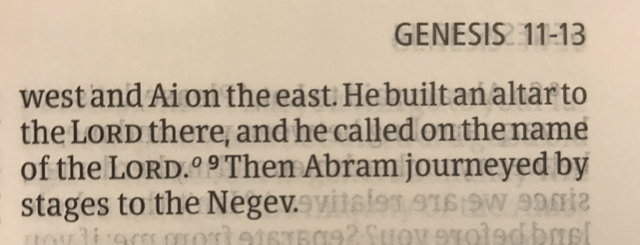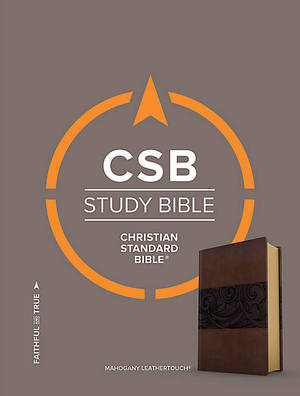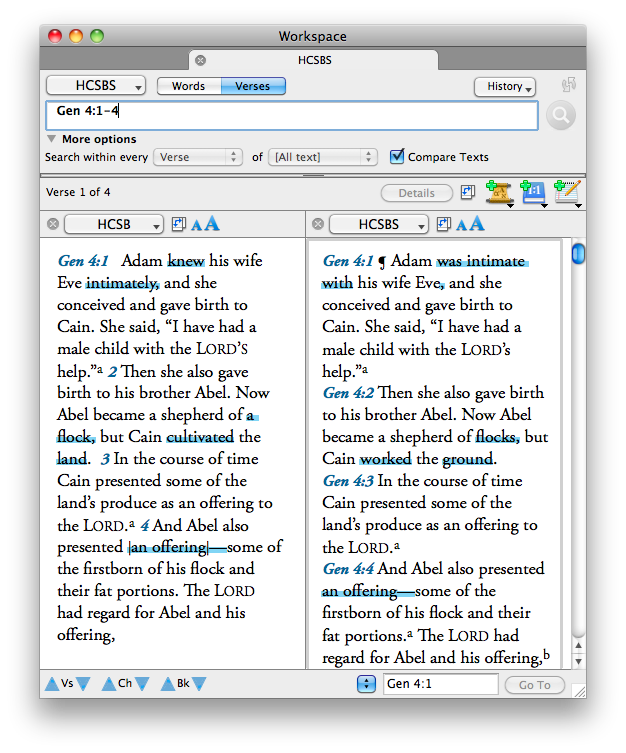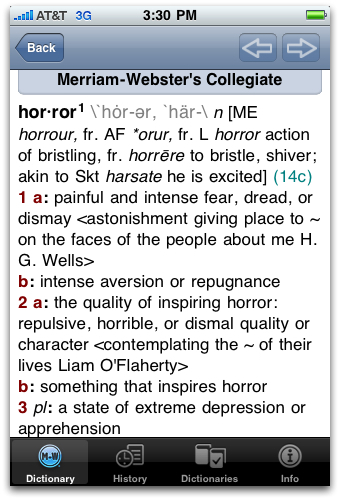 As of this writing, the only way to obtain a copy of the 2009 edition of the Holman Christian Standard Bible is through WORDsearch Bible software. I've had a copy of the updated text for a while but haven't had an opportunity to make a thorough evaluation of the text. I imagine this will be easier to do once it's available in Accordance when I can put the two texts side by side. In the meantime, though, I thought it might be useful to look at selected texts, especially in regard to previous trouble spots.
As of this writing, the only way to obtain a copy of the 2009 edition of the Holman Christian Standard Bible is through WORDsearch Bible software. I've had a copy of the updated text for a while but haven't had an opportunity to make a thorough evaluation of the text. I imagine this will be easier to do once it's available in Accordance when I can put the two texts side by side. In the meantime, though, I thought it might be useful to look at selected texts, especially in regard to previous trouble spots.
As mentioned in an earlier post, the 2009 HCSB will neither be designated as "revised" nor as a "second edition." The publisher does not feel that the number of changes to the text are significant enough to warrant a change in designation. New print editions will begin to appear in 2010.
While there are numerous improvements in the 2009 text, unfortunately, some traditional formatting remains in the 2009 HCSB such as capitalized pronouns referring to deity (which can be problematic in certain passages) as well as brackets around words "supplied for clarity for the translators." Personally, I believe the latter, especially, is wholly unnecessary in any translation and certainly so in one deemed as using "optimal equivalence." Fortunately, it's been reported that there are fewer brackets in the new text.
While I've stated before that overall, I believe the HCSB is one of the most technically accurate translations available (see for instance the discussion of John 3:16 in my original review), there were a handful of rather odd renderings in the original HCSB. The most infamous of these was found in Eph 2:2 which I'm glad to report has been changed in the 2009 HCSB:
| Ephesians 2:2 |
| 2004 HCSB |
2009 HCSB |
in which you previously walked according to this worldly age, according to the ruler of the atmospheric domain,a the spirit now working in the disobedient.b
aLit ruler of the authority of the air
bLit sons of disobedience |
in which you previously walked according to the ways of this world, according to the ruler who exercises authority over the lower heavens,a the spirit now working in the disobedient.b
aLit ruler of the domain of the air
bLit sons of disobedience |
Of course the phrase originally questioned was "the ruler of the atmospheric domain" (τὸν ἄρχοντα τῆς ἐξουσίας τοῦ ἀέρος], traditionally rendered "the prince of the power of the air" (KJV/NASB/ESV) or "the ruler of the kingdom of the air" (NIV). This phrase is admittedly difficult to convey in English from a standpoint of its original intended meaning. The 2009 text is mildly better, but I still have trouble hearing that from the pen of an ancient writer. The NLT is more helpful here: "the commander of the powers in the unseen world."
Deluge No More
The original HCSB also had an unusual choice for the word traditionally rendered flood (מַבּוּל) in regard to the Noah story. The HCSB opted for deluge in ten places: Gen 6:17; 7:6-7, 10, 17; 9:11, 15; 10:1; 11:10. There's nothing technically wrong with the word deluge. It is often the word used in academic circles and is even used in the HALOT entry for מַבּוּל. However, it always seemed strange when read in front of a group at church. No, I'll be honest. It seemed odd when even reading it to myself.
The 2009 HCSB simply renders מַבּוּל as flood. For use in the church, this helps a lot.
Use of Yahweh
The original HCSB broke with most English translations to render the divine name, יהוה, as Yahweh (instead of LORD--all caps) in 75 places: Exod 3:15-16; 6:2-3, 6-7; 15:3; 33:19; 34:5-6; Deut 7:9; 28:58; Judg 6:24; 1 Kgs 18:21, 24, 32, 37, 39; 22:7; 2 Kgs 5:11, 17; 2 Chr 18:6; Ps 68:4; 81:10; 83:18; 143:11; 145:3; Isa 30:27; 40:28; 42:8; 48:2; 51:15, 22; 54:5; Jer 16:21; Lam 3:55; 5:1; Ezek 6:14; 17:21, 24; 20:48; 36:23; 48:35; Dan 9:20; Hos 12:5; Joel 2:26, 32; Amos 4:13; 5:6, 8, 16, 27; 6:8; 9:6, 15; Jonah 1:9, 14; Mic 4:5; 5:4; Hab 1:12; 3:19; Zeph 3:9, 12, 20; Hag 1:14; Zech 14:7, 9; Mal 3:6, 16.
The 2009 HCSB increases this rendering to 504 occurences: Gen 4:26; 12:8; 13:4; 14:22; 21:33; 22:14; 26:25; Ex 3:15-16, 18; 4:5, 22; 5:1-3; 6:2-3, 6-8, 29; 7:5, 16-17; 8:1, 8, 10, 20, 22; 9:1, 13, 27-30; 10:2-3, 7-11, 16-17, 24-26; 11:4, 7; 12:12, 31; 14:4, 18, 25; 15:3, 26; 16:12, 15; 18:11; 20:2, 5, 7, 10-12; 29:46; 31:13, 19; 34:5-6, 14; 18:21; Lev 18:21; 19:12; 21:6; 22:2; 22:31; 24:16; Num 6:24-26; 15:41; 36:2; Deut 1:11, 21; 4:1; 5:6, 9, 11-12, 14-16; 6:3-4, 13; 7:9; 10:8, 20; 12:1, 5, 11, 21; 14:23-24; 16:2, 6, 11; 18:5, 7; 21:5; 26:2, 7; 27:3; 28:58; 29:25; 32:3; Josh 22:22; 24:14, 15, 19, 22, 31; Judg 6:24; 7:18, 20; 10:16; Ruth 1:17; 1 Sam 17:45; 2 Sam 6:2, 18; 1 Kings 5:3, 5; 8:17, 20, 44, 60; 10:1, 9; 11:4, 6, 9; 14:21; 18:21, 24, 32, 36-39; 20:28; 22:8, 15-16; 2 Kings 3:11; 5:11, 17, 25, 28; 18:6; 19:4; 1 Chron 16:2, 8, 10, 29, 36; 17:24. 26; 22:7, 19; 23:13; 29:16; 2 Chron 2:1, 4; 6:7-8, 10-11, 14, 16; 12:6; 13:9-11; 14:11, 13; 15:9; 16:8-9; 18:6-7, 15; 19:4; 20:6, 17, 20, 29; 21:10, 12, 14; 24:18, 24; 28:10; 29:5, 10; 30:1, 5-9, 19, 22; 32:8, 11, 17; 33:4, 12-13, 16-18; 34:21, 23-24, 26, 33; 35:3; 36:13, 15; Ezra 4:1, 3; 6:21; 7:6, 27-28; 9:5, 8; 10:11; Neh 1:5; 9:5-7; 10:29; Job 1:21; Psalm 7:1, 3, 17; 8:1, 9; 9:1, 10; 16:2; 18:31, 49; 20:1, 5, 7; 22:23; 25:11; 29:1-2; 30:4; 33:12, 20, 22; 34:3, 9; 41:13; 46:11; 47:2; 48:8; 50:1; 54:6; 68:4; 69:31; 74:18; 79:5; 80:19; 81:10; 83:16, 18; 86:11; 89:15; 92:1; 96:2, 8; 97:12, 99:2, 6; 100:3, 5; 102:15, 21; 103:1, 22; 104:1, 35; 105:1, 3; 106:47-48; 109:21; 113:1-5; 115:1; 116:4, 13, 17; 118:10-12; 119:55; 122:4, 8; 129:8; 130:1, 3, 5; 135:1-6, 13-14, 19-20; 143:11; 144:15; 145:21; 148:5, 13; 149:4; Prov 18:10; Isa 12:4-5, 7; 24:15; 25:1; 26:8, 13; 30:27; 37:4; 40:28; 42:8; 44:6; 47:4; 48:1-2; 50:10; 51:15, 22; 54:5; 56:6; 59:19; 63:16-17; Jer 3:17; 10:6, 10, 16; 11:21; 12:16; 14:7, 9; 15:16; 16:21; 22:9; 23:6; 26:9, 26:16, 20; 31:6, 35; 32:18; 33:2, 16; 44:16, 26; 46:18; 48:15; 50:34; 51:19, 57-58; Lam 3:55; 5:1; Ezek 6:7, 14; 17:21, 24; 20:48; 36:20; 36:23; 39:6-7; 48:35; Dan 9:20; Hos 2:20; 7:10; 12:5, 9; 13:4; 14:1; Joel 2:26, 32; Amos 4:13; 5:6, 8, 16, 27; 6:8, 10; 9:6, 15; Jonah 1:9, 14; 2:7; Micah 4:5; 5:4; 6:9; 7:17; Nahum 1:11; Hab 1:12; 3:18-19; Zeph 3:2, 9, 12, 15, 17, 20; Hag 1:14; Zech 10:6-7, 11-12; 11:4; 13:3, 9; 14:7, 9; Mal 1:6, 11, 14; 2:2; 3:6, 16
Of course, even this increase in usage of Yahweh is less than 10% the the full number of times the divine name is used in the Old Testament (6828 hits according to a search in Accordance). Compare the HCSB, for instance, with the New Jerusalem Bible, which renders יהוה as Yahweh 6342 times.
Most of this kind of usage comes when there is specific reference to the name of God (Gen 4:26; 12:8; Ex 20:7, etc.) or when the God of the Bible is being contrasted with other gods such as the renewal of the Covenant at Shechem in Josh 24 (see specifically vv. 14, 15, 19, 22, 31) or Elijah's confrontation with the priests of Baal (1 Kings 18:21, 24, 32, 36-39). In these kinds of contexts, the use of Yahweh especially makes sense and has been something I've done for years on my own when reading this texts publicly. It makes no sense in 1 Kings 18:22 for Elijah to say "If the LORD is God, follow him, but if Baal, follow him" since Baal can mean "master" or "lord," too. The contest is between Yahweh and Baal, and the rendering in the HCSB clarifies this. The same can be said for Joshua before the Israelites in Josh 24. Only Yahweh makes sense in v. 15: "But if it doesn’t please you to worship Yahweh, choose for yourselves today the one you will worship: the gods your fathers worshiped beyond the Euphrates River or the gods of the Amorites in whose land you are living. As for me and my family, we will worship Yahweh” (emphasis added).
By the same token, though, the mixing of LORD and Yahweh in the same verse somehow seems unusual. Consider the following two examples:
"But Jehoshaphat said, 'Isn’t there a prophet of the LORD here? Let’s inquire of Yahweh through him.'” (2 Kings 3:11)
"So they called out to the LORD: 'Please, Yahweh, don’t let us perish because of this man’s life, and don’t charge us with innocent blood! For You, Yahweh, have done just as You pleased.'” (Jonah 1:14)
Somehow the mixing of LORD and Yahweh seems a bit unusual as if to suggest they're two separate words in the underlying Hebrew. Or take for example Psalm 119. יהוה occurs 24 times in Psalm 119 (1, 12, 31, 33, 41, 52, 55, 57, 64–65, 75, 89, 107–108, 126, 137, 145, 149, 151, 156, 159, 166, 169, 174), but Yahweh only occurs in v. 55 because "name" is specifically mentioned.
A Few Others
More comparisons will have to come later, but I did take a moment to look at the HCSB page over at the Better Bibles Blog. In the comments, a number of people suggested certain phrasings/renderings in the 2004 text that could be improved. Of course, these are varied opinions, and not everyone would agree that each suggestion is valid. Nevertheless, I decided to take a quick scan through those suggestions to see if any had been updated in the 2009 text. There weren't really very many that have been changed (and if you don't see it below, it remains the same), but besides Eph 2:2 and the issue over the choice of deluge, I found these:
| Genesis 4:1 |
| Adam knew his wife Eve intimately, and she conceived and gave birth to Cain. She said, “I have had a male child with the LORD’s help.” |
Adam was intimate with his wife Eve, and she conceived and gave birth to Cain. She said, “I have had a male child with the LORD’s help.” |
Proverbs 11:8
|
The righteous is rescued from trouble;
in his place, the wicked goes in |
The righteous one is rescued from trouble;
in his place, the wicked one goes in. |
1 Peter 2:6
|
For it stands in Scripture:
Look! I lay a stone in Zion,
a chosen and valuable cornerstone,
and the one who believes in Him
will never be put to shame! |
For it is contained in Scripture:
Look! I lay a stone in Zion,
a chosen and honored cornerstone,
and the one who believes in Him
will never be put to shame! |
Revelation 1:12
|
| I turned to see the voice that was speaking to me. When I turned I saw seven gold lampstands, |
I turned to see whose voice it was that spoke to me. When I turned I saw seven gold lampstands, |
1 John 3:17
|
| If anyone has this world’s goods and sees his brother in need but shuts off his compassion from him—how can God’s love reside in him? |
If anyone has this world’s goods and sees his brother in need but closes his eyes to his |need|—how can God’s love reside in him? |
1 Peter 1:13
|
| Therefore, get your minds ready for action, being self-disciplined, and set your hope completely on the grace to be brought to you at the revelation of Jesus Christ. |
Therefore, with your minds ready for action, be serious and set your hope completely on the grace to be brought to you at the revelation of Jesus Christ. |
A number of chapter comparisons between the 2004 and 2008 editions have been posted at the Christian Insight website. Robert Jimenez has written a number of posts about the 2009 HCSB on Inquiring Minds. Also, a special HT to Robert for alerting everyone to the new HCSB website, HCSB.org (you'd think that Lifeway would send out emails to HCSB supporters about this). Will Lee at Anwoth has an interview with Dr. Blum, the general editor of the HCSB, specifically about the second edition. And, of course, the ETS paper Dr. Blum presented last year comparing the HCSB to other translations was based upon the changes found in the 2009 text.
Again, once the 2009 text is available in Accordance, changes will be easier to determine, when I can set the 2004 and 2009 texts side by side and run Accordance's comparison feature. And, of course, I look forward to getting a print copy of the 2009 HCSB text in hand--even if that doesn't occur until 2010! What about you? Anyone else with a copy of the 2009 text? What other changes stand out to you? Anything significant? Leave your thoughts in the comments.
 Saturday, November 19, 2016 at 11:04PM
Saturday, November 19, 2016 at 11:04PM 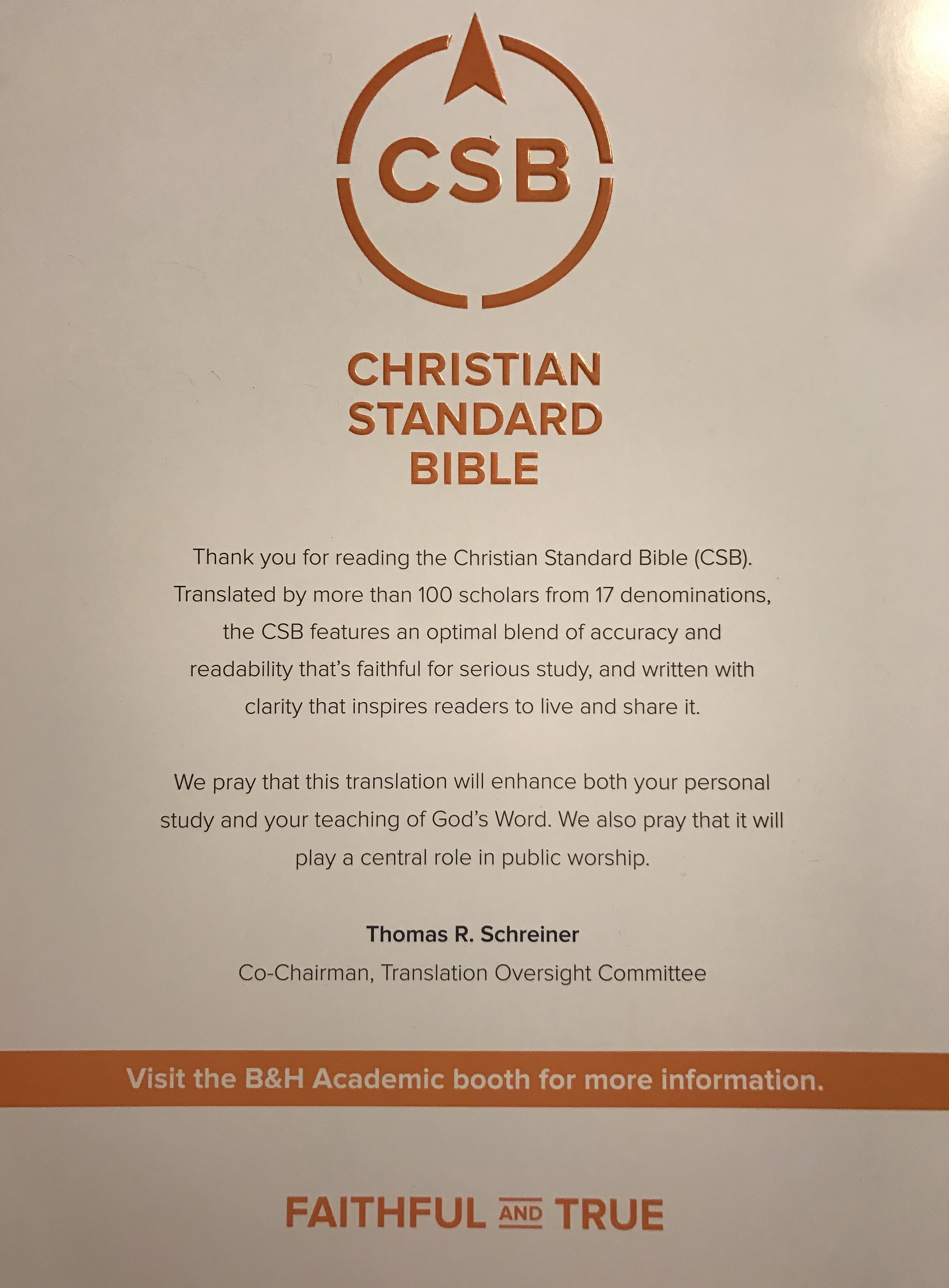
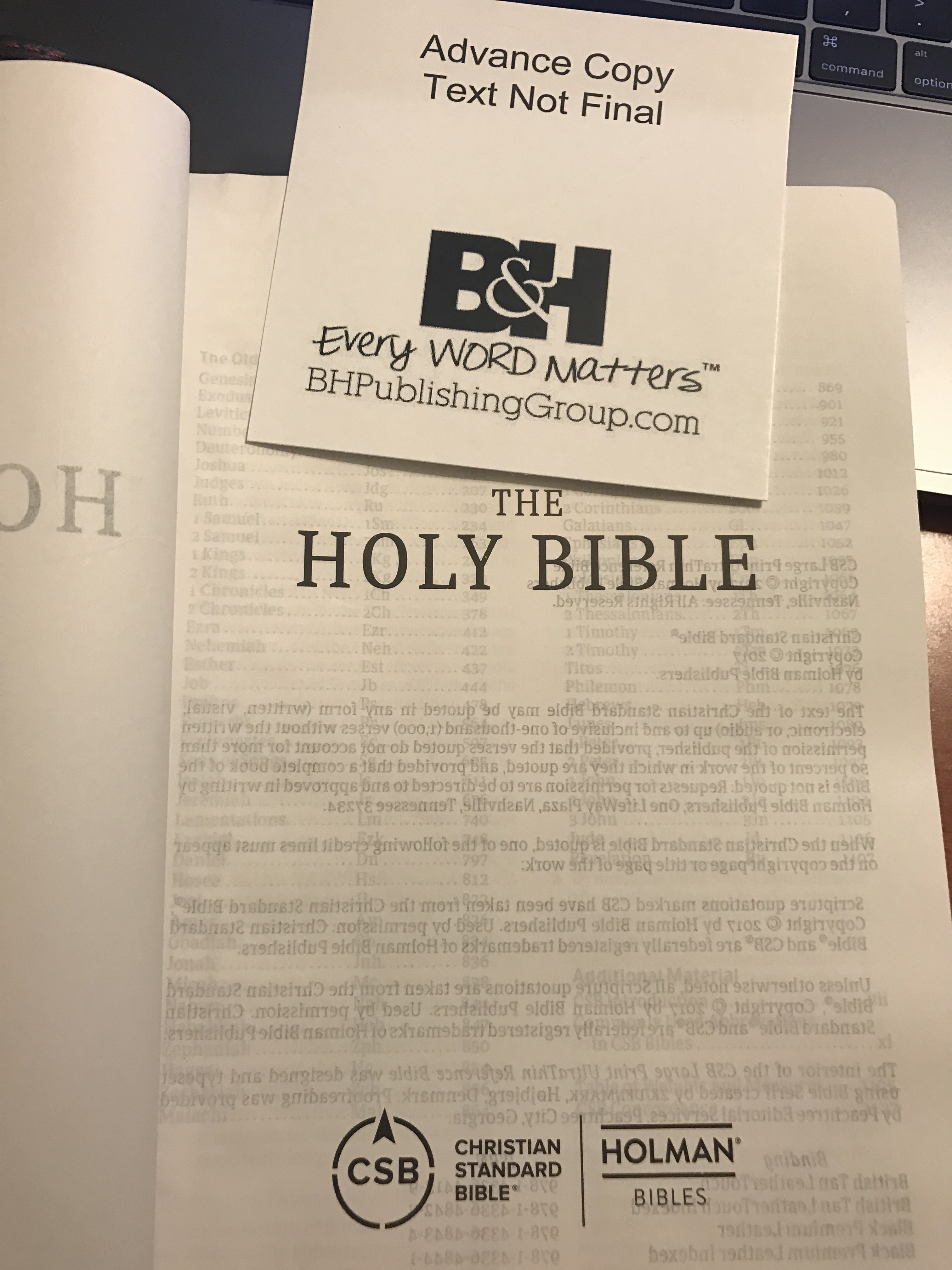
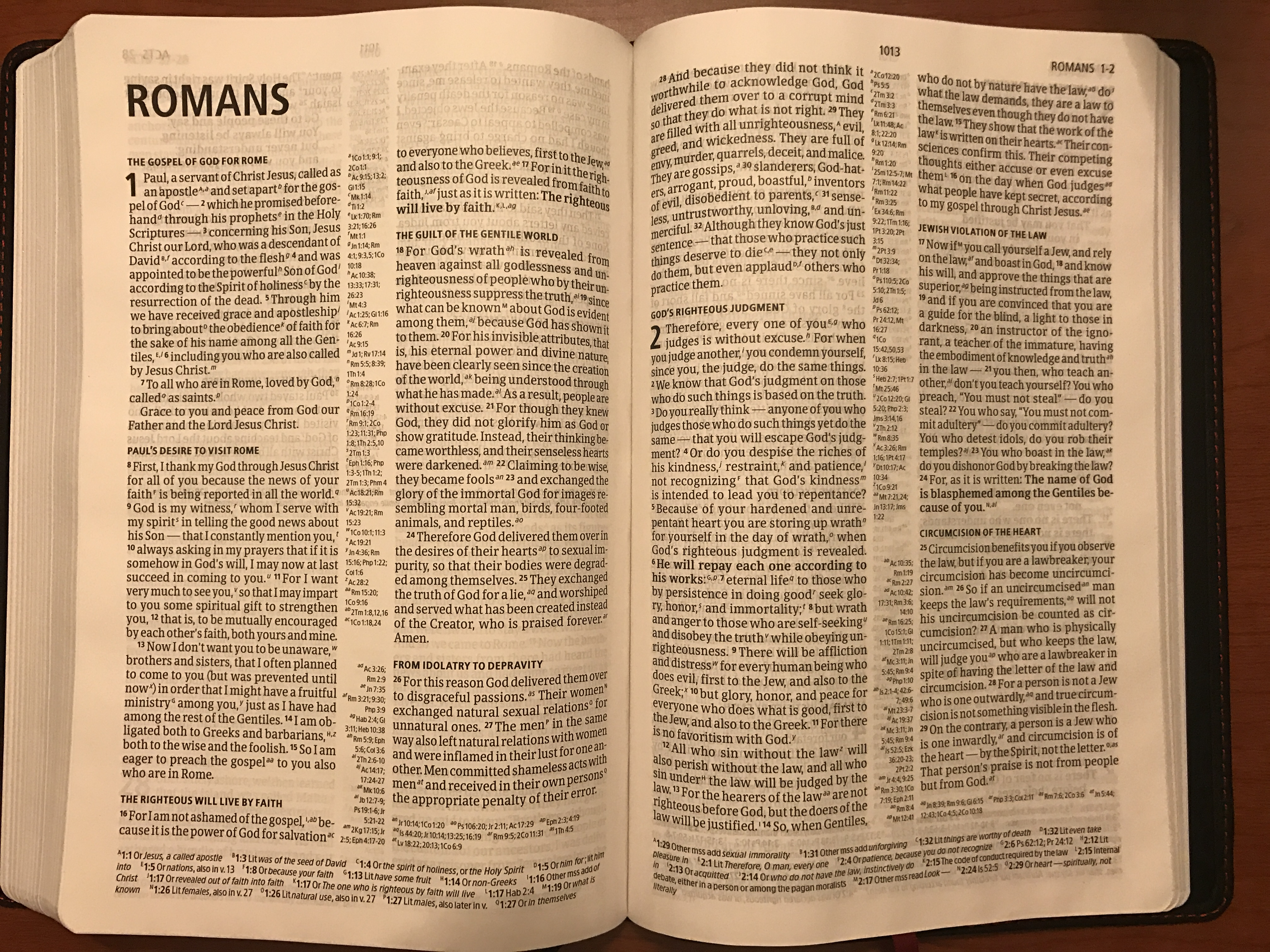
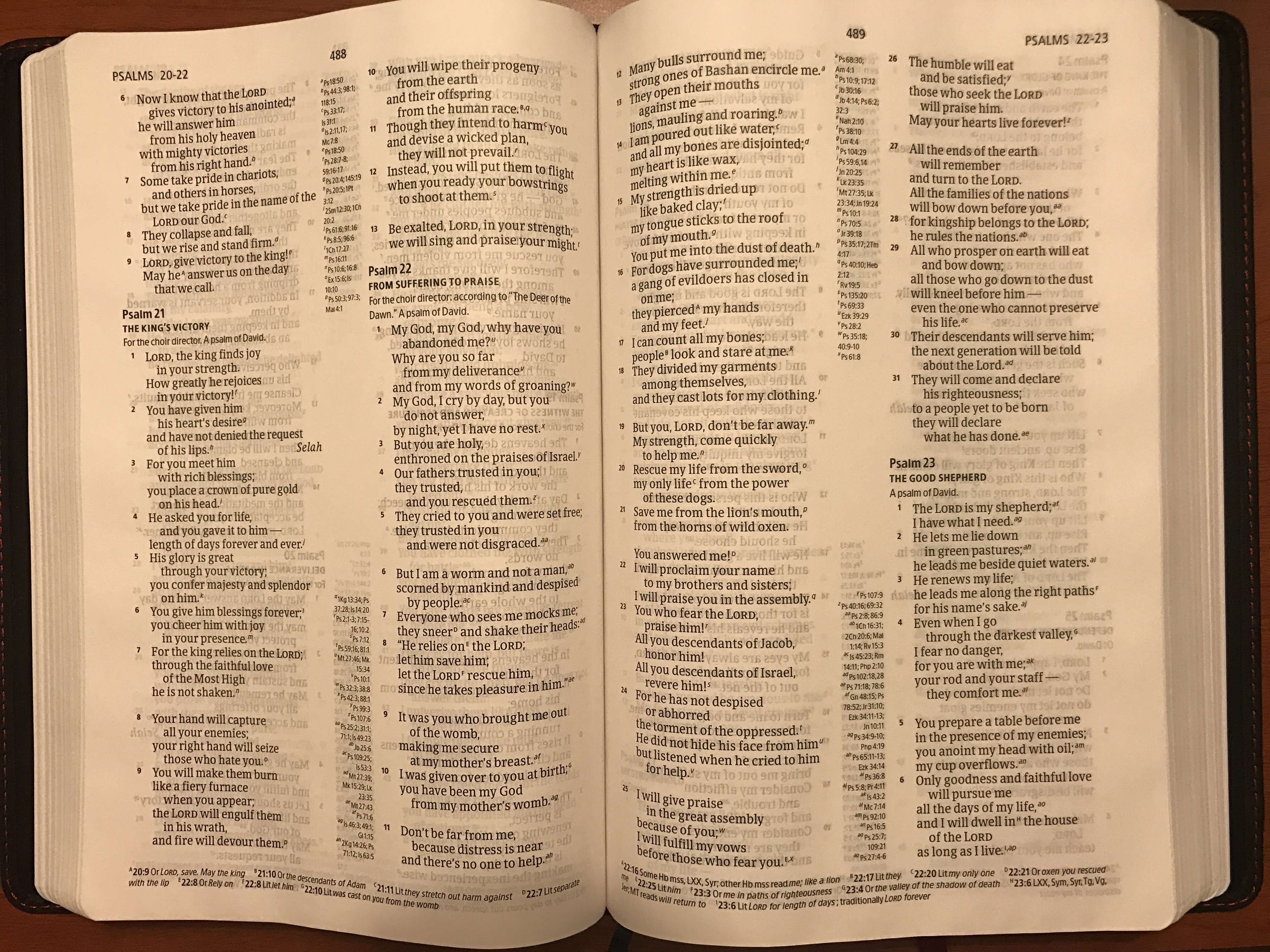
 R. Mansfield
R. Mansfield
 R. Mansfield
R. Mansfield
 CSB,
CSB,  HCSB in
HCSB in  Faith & Reason
Faith & Reason 

